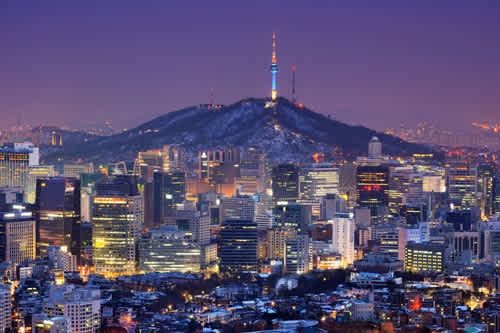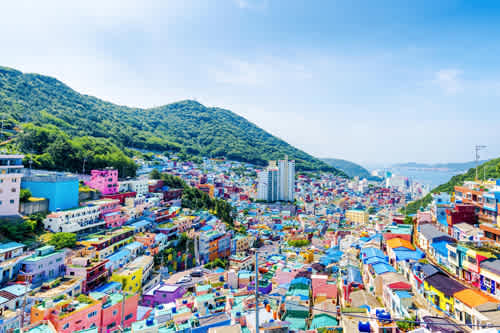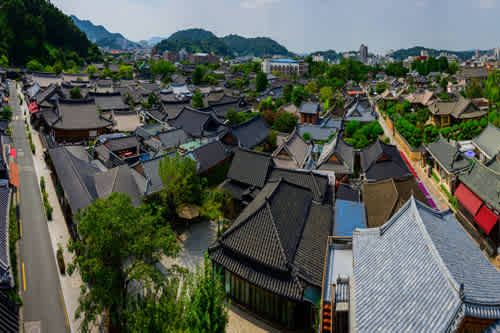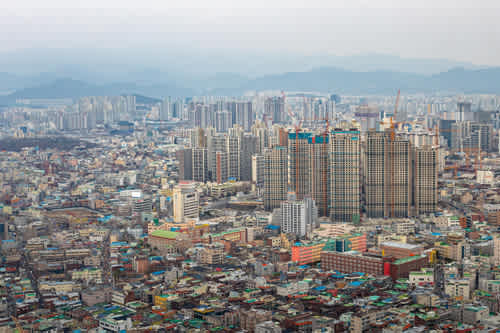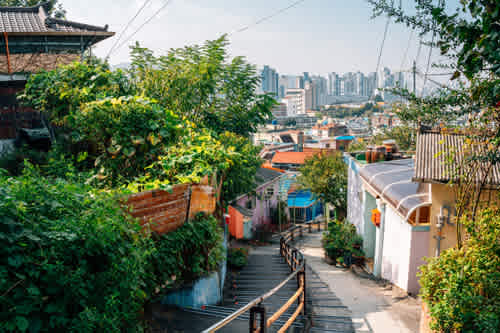South Korea’s harmonious blend of precious tradition and modernity is simply captivating.
About South Korea
Located in the southern half of the Korean Peninsula, South Korea is an area of Asia which hasn’t yet been widely discovered by tourists - but a fascinating, beautiful, and increasingly cool destination awaits. In fact, the experience begins upon landing at Incheon International Airport, the country’s new sleek hub, which is about way more than just flying. It is home to a golf course, skating rink, casino, spa, museum, cinema, and an array of dining options that makes choosing between them a challenging task.
South Korea is characterized by its lush countryside sprinkled with cherry trees and historic Buddhist temples, sub-tropical islands, and quaint coastal fishing villages, alongside state-of-the-art cities such as Seoul, its capital, and a demilitarized zone with North Korea. In short, traveling in South Korea means uncovering five thousand years of culture and history, basking in the beauty of outstanding landscapes, tall mountains, and tranquil bays, and enjoying cutting edge contemporary amenities.
Seoul, the starting point for most trips to South Korea, is a bustling city where you’ll find ultra-modern design right next to traditional, small homes and historic icons. Royal palaces, which have been restored to their former glory, are among the top Seoul attractions. The five major palace complexes in Seoul are: Gyeongbokgung Palace (the Northern Palace), Changdeokgung Palace, Changgyeong Palace, and Deoksugung Palace. While the palaces have been popular day destinations, they are now teeming during the night hours, as well, as tourists flock there for moonlight tours when the subtle lighting and different acoustic effects create a magical atmosphere.
Gyeongbokgung Palace, built in 1395, is the oldest and largest of the palaces and is thought to be the most beautiful. Changdeokgung Palace (the Eastern Palace), built in 1405, is the best preserved palace and served as the main residence of many of the kings from the Joseon dynasty. Changgyeonggung Palace, also dating back to the 15th century, was originally built by King Sejong for his retiring father, King Taejong. Deoksugung Palace is located in the heart of Seoul’s busiest district, alongside Western style buildings, and is known for its graceful stone-wall road. Gyeonghuigung Palace (the Western Palace) served as a secondary palace for the king and was used in times of emergency to ensure his safety.
What other tourist attractions are there in Seoul?
If you’re looking for culture, Seoul’s many museums don’t disappoint. Within the Gyeongbokgung Palace grounds, you’ll find the National Palace Museum of Korea with a myriad of fascinating items from the Joseon Dynasty, and the National Folk Museum of Korea which tells the story of the Korean people throughout history via historical objects from daily life. The Seoul Museum of Art (SeMa), located behind the Deoksugung Palace, is home to large collections of art- mainly Korean art from the modern era, though it also has a significant collection of international pieces. The National Museum of Korea illustrates the history and artwork of Korea and its people, with a vast collection of art, history, and archeology, some of which date back to prehistoric times.
Looking for spectacular views of the city?
The N Seoul tower, a communications tower which rises almost 500 meters above the city, is perched on the side of Mount Namsan. A cable car will bring you to the base of the tower, and from there you can climb up the tower to its four observation decks, one of which is a revolving restaurant. And, from the top of the vase-shaped Lotte World Tower skyscraper, the tallest building in South Korea and one of Seoul’s newest attractions, there are 360-degree views of the city from the indoor and outdoor observation areas (the Seoul Sky). Don’t miss the Sky Deck on the 118th floor with its glass floor which changes from opaque to clear. Known as the Giant Vertical Metropolis, the tower also includes a luxury hotel, the Lotte World Aquarium, the Lotte Museum of Art, and a huge shopping mall.
For a slice of Korean tradition, culture, and architecture, visit the Bukchon Hanok Traditional Village. This preserved district of several ancient neighborhoods will take you back 600 years to life in Korea.
Other Seoul attractions include The Blue House, the official residence of the Korean president which is actually a campus of traditional-style buildings featuring blue tile roofs, and Bongeunsa, one of the city’s famous Buddhist temple complexes. The ancient Sungnyemun Gate, also known an Namdaemun Gate, is the largest surviving castle gate stone structure and one of South Korea’s famous treasures.
Seoul also has many options for a green escape. Take a stroll along Cheonggyecheon, known as Seoul's Urban Stream, which flows through the central part of the city. Having been covered by highways after the Korean War economic boom, seven miles of the creek have been uncovered and turned into walking, hiking, and biking trails. Bukhansan National Park offers another beautiful green escape with its forested areas, temples, and granite peaks. Set within the park’s beautiful landscape and trails is Jingwansa, an ancient temple complex, which offers visitors the opportunity to learn about and experience Buddhism. The Han River, which played an important part in the country’s history, is now a great destination for bike riding, picnics, watching night light shows - and, of course, river cruises.
Shopping in Seoul? The massive commercial district, Dongdaemun Market (officially known as Heunginjimun Gate), is a great place to start. Dongdaemun encompasses four large markets, many of which sell clothing, and the Gwangjang Market which also has a wide array of famous Seoul street food. With all the choices, it’s hard to know what to choose so be sure to ask for samples- and you’ll be tasting your way through the market. Namdaemun Market is another large traditional market filled with things to buy, eat, and see. And Insadong, a unique neighborhood teeming with shops and galleries selling traditional Korean handicrafts, art, and clothing is another must. The area also has many tea houses and cafes.
Venturing out of Seoul, what areas are worth visiting?
Nami Island is one of South Korea’s most popular destinations – especially for those looking for a romantic get-away. Located near Seoul, Nami is a half-moon shaped island full of beauty, charm, and mystique which has also been a popular filming spot for a variety of movies and shows, including the popular Winter Sonata.
The five-kilometer long DMZ, Korean Demilitarized Zone, which separates North and South Korea is another top attraction. The area, which can only be visited as part of an organized tour, is surrounded by electric fences and soldiers on both sides of the border. The nearby Imjingak Park, outside the city of Paju, has many statues and monuments related to the Korean War, and the Freedom Bridge, located in the park, is a former railway bridge which repatriated soldiers and POW’s crossed as they returned home from the North after the Korean War.
Whether you’re traveling with kids or just adults, Everland Resort is a destination to be enjoyed by young and old alike. The largest theme park in Korea, Everland encompasses not only a massive complex of exciting shows and rides, but themed festivals, a water park, and a zoo.
Another destination for thrills and fun is Seoulland, Korea’s first theme park. The park is surrounded by beautiful scenery and includes over 50 rides and seasonal attractions such as its famous Laser Show.
Busan is South Korea’s second largest city and offers a range of popular attractions from seafood markets and skywalks to beaches and bars. Haeundae Beach, where skyscrapers overlook the South Sea, and the Haedong Yonggungsa Temple which is perched on a cliff are must-sees in Busan as is the Gamcheon Culture Village and the observation deck at Mt. Hwangnyeongsan. For seafood lovers, Jagalchi market, is the place to be. Nightlife in Busan? Korean barbecues, night markets, and karaoke abound. Shopping is a favorite recreational activity in Busan and, in addition to the traditional markets, there are large modern malls and department stores.
Since seventy percent of the Korean Peninsula is covered by mountains, these ranges are part of many tourist itineraries. The Bukhan Mountain outside Seoul with its spectacular views and relaxing saunas is a popular destination as is Seoraksan National Park in the north. The park encompasses crystal clear streams and lakes, jagged mountains, unusual wildlife, and beautiful vegetation.
A trip to South Korea wouldn’t be complete without a visit to the southern island of Jeju, a UNESCO World Heritage Site, and one of the new seven wonders of the natural world. Jeju, the country’s largest island, is known for its resorts and exceptional volcanic terrain. Among the island’s many volcanic cones, Abu Oreum and Baekyaki Oreum are among the most famous. The island’s unusual Dragon Coast is a well-known attraction, and the Hyupjae, Hamdeok, and Gumneung beaches lure visitors with their fine sand and crystal emerald-shaded water. Jeju’s Hallim Park has a variety of beautiful botanic gardens and its two-dimensional caves are extraordinary. The Jeju Osulloc Tea Museum, shaped like a green tea cup, teaches visitors about Korea's traditional tea culture. Take your cup of unique Osulloc tea and relax near the lotus pond in the indoor garden.
The best time of the year to visit South Korea?
March to May is ideal for experiencing the vibrant cherry blossoms in bloom and the most moderate temperatures. The Korean rainy season starts in mid June and can last through August, and this period tends to be also hot and humid. September to November bring peak foliage season and moderate temperatures, and January, the cheapest time, enables you to partake in a range of winter sports activities at some of South Korea’s great ski resorts.
A ten to twelve day trip to South Korea is considered to be the minimum for exploring Seoul as well as a variety of the country’s other popular destinations.
Ready to experience South Korea’s enchanted harmony between East and West? RoutePerfect is your address for planning, organizing, and booking your personalized, magical vacation to South Korea. Unlike any other company, Routeperfect offers its exclusive popular itineraries written by tourism professionals and experienced travelers to jumpstart your planning, helping you to customize your travel and book your accommodations so that you can experience the country YOUR way.
Popular Itineraries
Traveled by thousands
Regions in South Korea
Attractions in South Korea
- Dosan Seowon, Andong
- Historic Center, Andong
- Beomeosa Temple, Busan
- City Center, Busan
- Jagalchi Market, Busan
- Historic Center, Cheongju
- Historic Center, Chuncheon
- Historic Center, Daegu
- Historic Center, Daejeon
- Historic Center, Gongju
- Gwangju National Museum, Gwangju
- Historic Center, Gwangju
- May 18 National Cemetery, Gwangju
- Bulguksa Temple, Gyeongju
- Gyeongju National Museum

